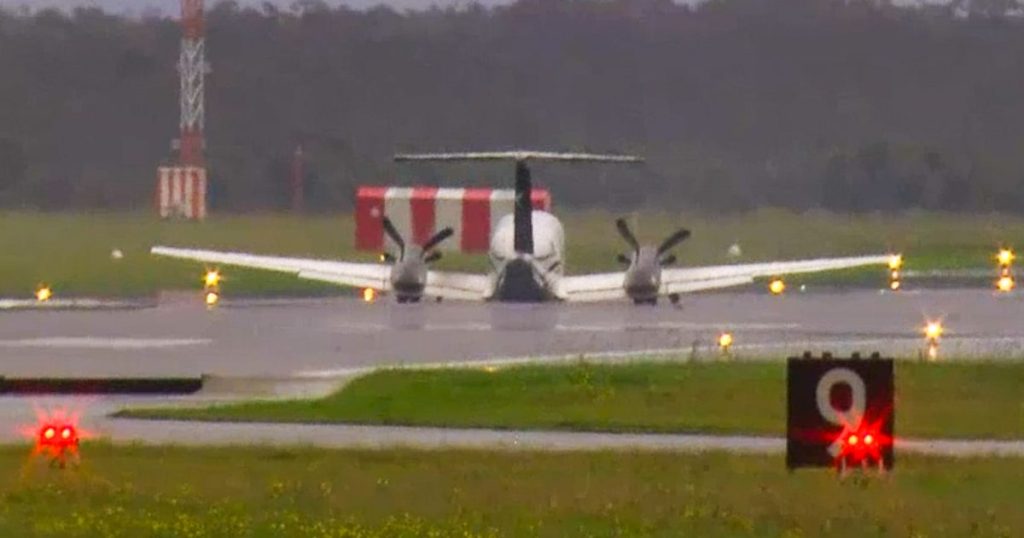A light plane with three people aboard successfully made an emergency landing without landing gear at an Australian airport after experiencing mechanical issues. The twin-turboprop Beechcraft Super King Air had just taken off from Newcastle Airport for a flight to Port Macquarie when the pilot raised the alarm. The plane circled the airport for nearly three hours to burn off fuel before landing safely on the tarmac. Emergency services, including fire engines and ambulances, were on standby during the tense situation. The pilot’s decision to return to Newcastle was due to the better emergency response resources available there compared to Port Macquarie. Aviation safety expert Ron Bartsch praised the pilot for executing a safe landing and preventing a potentially worse outcome. The Australian Transport Safety Bureau will investigate the incident to determine the cause of the mechanical failure.
The successful emergency landing of the plane showcased the skill and professionalism of the pilot in handling a challenging situation. By choosing to return to Newcastle Airport, the pilot ensured that there were adequate resources available to support the landing without landing gear. The quick thinking and decisive actions of the pilot helped to prevent a more serious incident from occurring. Despite the mechanical issues faced by the aircraft, the pilot managed to bring the plane down safely, highlighting the importance of training and experience in aviation emergencies. The response of emergency services also played a crucial role in ensuring the safety of those on board.
Authorities noted that the plane experienced mechanical issues, specifically a failure of the landing gear. This type of malfunction poses significant risks during takeoff and landing, as the landing gear is crucial for a smooth and controlled touchdown. The pilot’s decision to circle the airport and burn off fuel before attempting the landing was a strategic move to minimize potential risks and increase the chances of a successful outcome. The incident highlights the importance of proper maintenance and regular inspections of aircraft to prevent unexpected failures during flight. The investigation by the Australian Transport Safety Bureau will provide more insight into the cause of the mechanical issue and any contributing factors.
The incident drew attention to the critical role of emergency response resources in ensuring the safety of aviation operations. The availability of fire engines and ambulances at the airport demonstrated the preparedness of the authorities to handle emergencies effectively. In situations where quick decisions need to be made, having access to essential support services can make a significant difference in the outcome of an emergency landing. The coordination between the pilot, air traffic control, and emergency services during the incident showcased the importance of effective communication and collaboration in managing crisis situations. The successful outcome of the emergency landing can be attributed to the seamless coordination between all parties involved.
The safe landing of the plane without landing gear was hailed as a textbook-style execution by the pilot, indicating a high level of skill and expertise in handling challenging aviation situations. The pilot’s ability to shut off fuel and electrics to reduce the risk of fire during the belly-up landing demonstrated a deep understanding of emergency procedures and protocols. The focus on ensuring the safety of all passengers on board reflects the commitment of aviation professionals to prioritize safety above all else. The incident serves as a reminder of the importance of continuous training and preparedness in the aviation industry to effectively manage unexpected emergencies and mitigate risks. The experience and quick thinking of the pilot played a crucial role in the successful outcome of the emergency landing.
Overall, the incident highlighted the resilience and professionalism of the aviation community in responding to unexpected challenges during flight operations. The successful emergency landing of the plane without landing gear underscored the importance of training, preparedness, and effective communication in managing crisis situations. The collaborative efforts of the pilot, air traffic control, and emergency services resulted in a safe outcome for all individuals involved. The investigation by the Australian Transport Safety Bureau will provide valuable insights into the incident and help enhance safety measures to prevent similar occurrences in the future. The incident serves as a testament to the dedication and expertise of aviation professionals in ensuring the safety and security of air travel.


